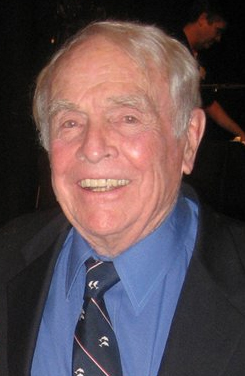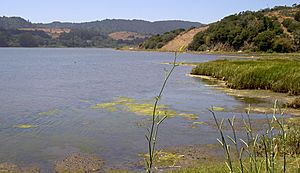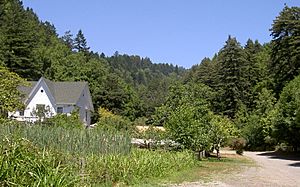L. Martin Griffin facts for kids
Quick facts for kids
L. Martin Griffin Jr.
|
|
|---|---|
 |
|
| Born | Loyal Martin Griffin Jr. July 23, 1920 Ogden, Utah, U.S. |
| Died | May 22, 2024 (aged 103) |
| Occupation | Doctor, writer, environmentalist, vintner |
| Nationality | American |
| Period | 1998–2024 (as writer) |
| Genre | Nature writing, Environmentalism |
| Subject | Ecology, Conservation |
| Notable works | Saving the Marin-Sonoma Coast |
Loyal Martin Griffin Jr. (July 23, 1920 – May 22, 2024), known to many as Marty Griffin, was an American hero for nature. He worked hard to protect wild places in Northern California. Marty was also a doctor and wrote a book called Saving the Marin–Sonoma Coast. He helped lead groups like the Marin Audubon Society and owned a winery.
Marty was celebrated for his many years of work. He helped save important homes for wildlife in Sonoma and Marin County for decades. Even the National Park Service has a page honoring him!
Contents
Early Life and Education
Marty Griffin was born on July 23, 1920, in Ogden, Utah. His family moved to California when he was young. As a Boy Scout, he spent time in nature. This made him love wild places and fly fishing.
He decided to study medicine. Marty graduated from Stanford University. After that, he became a doctor in Marin County. He worked as an internist, a doctor who treats adults.
Protecting Nature: Marty's Activism
Marty Griffin was a strong voice for the environment. He worked to protect many natural areas. He learned from other environmental leaders.
Who Inspired Marty?
Marty said his heroes were John Muir and Teddy Roosevelt. He also admired Congressman William Kent. Kent helped create Muir Woods National Monument in Marin. He also started the movement to save Mount Tamalpais.
Marty also learned from Caroline S. Livermore. She helped start the Marin Conservation League. She taught him how to raise money to buy land. This helped protect areas from being built on.
Saving Bays and Lagoons
Marty worked with activist Elizabeth Terwilliger. They helped create wildlife areas along Richardson Bay. Their efforts stopped people from filling in the bay. This saved the bay from becoming a housing development.
Marty used the same idea to protect Bolinas Lagoon. In 1962, he wrote a check for $1,000. This held a key property called Canyon Ranch. Today, it is Audubon Canyon Ranch. He then asked the Audubon Society for help. They raised the rest of the money needed.
Later, Marty helped buy more land around the lagoon. He also worked to protect Tomales Bay. A city was planned for the east side of this bay. Marty said they had to keep their plans secret. This was so developers wouldn't find out.
Stopping a Freeway and a Power Plant
Marty also helped stop a freeway plan. This freeway would have gone from the Golden Gate Bridge to Sonoma County. It would have allowed a lot of building along its path. The plan aimed to bring 150,000 new people to the coast. This included building homes in what is now Point Reyes National Seashore.
Marty said, "I was horrified when I saw the maps." He knew the freeway would harm Bolinas Lagoon and Tomales Bay. He felt they had to save these places.
He also helped stop the Bodega Bay Nuclear Power Plant. This plant was planned for Bodega Bay on the Sonoma coast. It was going to be built right on the San Andreas Fault. Marty's work helped stop its construction. He also worked to stop a water pipeline. This pipeline would have gone from the Russian River to Marin.
Scott Feierabend, from Audubon Canyon Ranch, praised Marty's work. He said Marty understood how special the coastlines were. He knew that buying key properties would stop big construction projects.
Protecting Land in Sonoma County
Marty was also active in Sonoma County. He owned the Hop Kiln Winery there. He lived in Sonoma County for 30 years. He helped create the Bouverie Audubon Preserve. This was made possible by a gift from David Bouverie.
Marty also helped start the Friends of the Russian River. This group protects the Russian and other rivers. They fight against logging, mining, and dams. He also helped create the Griffin Russian River Riparian Preserve.
Point Reyes National Seashore and a Film
Even in his 90s, Marty kept speaking out. He spoke against a shellfish farm at Point Reyes National Seashore. This farm was in a sensitive area called the Phillip Burton Wilderness. He wrote that Drakes Estero was important. It was home to harbor seals and a nursery for fish. It was also a refuge for birds.
In 2012, Marty strongly opposed the Drakes Bay Oyster Company. He said Senator Dianne Feinstein was blocking efforts to close it. He believed the estero should "go wild."
Marty's efforts, and those of others, paid off. In November 2012, the U.S. Interior Secretary, Ken Salazar, decided not to renew the oyster farm's lease. Marty was happy with the decision. The farm was completely cleaned up by May 2017.
Marty also appeared in a documentary film. It was called Rebels with a Cause. The film was about saving land in Marin County. Actress Frances McDormand narrated the movie. It showed how successful the conservation efforts were.
Personal Life and Legacy
Marty Griffin lived in Belvedere, California. He turned 100 years old in July 2020. He passed away on May 22, 2024, at the age of 103. His work continues to inspire many.
Honors and Awards
Marty Griffin received many honors for his environmental work:
- The Griffin Loop Trail at Audubon Canyon Ranch is named for him.
- He won the 'Ted Wellman Water Award' in 1997.
- In 2005, he received the Citizen Emeritus Award from Belvedere.
- Marin Magazine named him one of Marin's 13 Most Influential in 2007.
- He also received the 2007 Environmental Leader of Marin Award.
- In 2010, the 1,000-acre Bolinas Lagoon Preserve was renamed the Martin Griffin Preserve.
- He won the 'Bay Nature Award' for lifetime achievement in 2011.
- In 2013, he received the first John Muir Legacy Conservation Award.
- The National Park Service honored his 100th birthday in 2020. They created a webpage dedicated to him.



